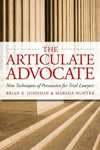 Verdict: It’s a Keeper
Verdict: It’s a Keeper
The Mock Trial Coach’s Bundle
By Brian K. Johnson & Marsha Hunter (Phoenix, AZ: Crown King Books, 2013). “Bundle” includes: The Articulate Advocate: New Techniques of Persuasion for Trial Lawyers; Mock Trial Student Practice Guide; The Articulate Advocate: Speaking Persuasively, Thinking on Your Feet; The Articulate Advocate: Video Review Checklist; The Articulate Witness: Mock Trial Tips; Training Videos. Order, www.crownkingbooks.com.
Reviewed by Ellen Henak
Most attorneys love words. As mock trial coaches, we concentrate on finding the right words. But the nonverbal components of our in-person communication – voice, gestures, and other uses of the body – also matter. They add to, or detract from, the words, for the listener and can affect the ease of thinking on one’s feet. This bundle of book, handouts, and videos is aimed at mock-trial participants and focuses on improving oft-neglected nonverbal communication.
The authors’ preparation techniques should be familiar to anyone who has taken singing lessons: plant your feet and only move intentionally, place hands in the ready position, take a deep breath, set your pace, and use the same ritual each time. Only “find your starting pitch” is missing, even though those of us with voices that tend toward screeching or rumbling need to do that also. Similarly, the authors advocate other voice-performance techniques: thinking in phrases, using large gestures slowly and right in front of your body, and being aware of your posture.
Want to Review a Book?
Have you read a great book that would be of interest to State Bar members? Or one that you want to make sure no one else wastes their time reading? Be a reviewer! Contact us at wislawmag@wisbar.org.
The following books are available for review. Please request the book and writing guidelines from Wisconsin Lawyer managing editor Karlé Lester, at klester@wisbar.org or (608) 250-6127. Reviewers may keep the book reviewed. Reviews of about 500 words are due within 45 days of receiving the book. Reviews are published in the order received and may be edited for length and clarity.
- Anatomy of a Trial: Public Loss, Lessons Learned from the People vs. O.J. Simpson, by Jerrianne Hayslett (Columbia, MO: Univ. of Missouri Press, 2013). 272 pgs. $27.49. Order, www.amazon.com.
- A Story of Lawyers and A Story of Lawyers with Views from the Bench, both by Jacqueline J. Buyze (Naples, FL: Jacqueline Buyze, Esq., 2013). Approx. 30 pgs each. $14 each. Series, children’s books.
- Swimmer (novel), by Brett Reetz (Minneapolis, MN: Two Harbors Press, 2011). 526 pgs. $12.60.
In addition, the authors’ practice techniques, to which they devote an entire chapter, also follow the traditional steps in musical practices: warm up, focus on general problem areas (such as transitions), focus on specific problem areas (such as speaking too softly or using an ever-present “um”), and go through the entire performance to the extent possible in many different settings.
A few students and most coaches likely are already familiar with these techniques. Nevertheless, the techniques presented are sound and provide a vocabulary for discussing the nonverbal aspects of advocacy. As the authors note, saying “be natural” or “relax” is of less use than explaining that natural-looking gestures are more likely when your hands are at your waist in the ready position and that taking a deep breath helps get adrenaline under control. In addition, as the authors demonstrate in the accompanying videos, gestures can help structure an opening or closing statement at trial and help students remember more and rely on notes less.
One drawback to this product is that the book and the handouts have too many words. The videos are far superior teaching tools. They demonstrate the authors’ points more powerfully and succinctly. The visual aids in the videos, color coded and in short phrases, are far more accessible and memorable than either the handouts or the book. The bottom line: yes to the videos, maybe to the book and handouts.
Ellen Henak, New York Univ. 1983, is a shareholder at Henak Law Office S.C., Milwaukee, concentrating on criminal appellate and postconviction work. She also is the cochairperson of the high school mock trial subcommittee of the State Bar of Wisconsin’s Public Education Committee.
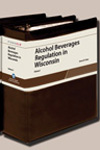 Verdict: It’s a Keeper
Verdict: It’s a Keeper
Alcohol Beverages Regulation in Wisconsin
By Aaron R. Gary (Madison, WI: State Bar of Wisconsin PINNACLE®, 2012). 1,121 pgs. $219 (members), $235 (nonmembers). Order, www.wisbar.org.
Reviewed by Barry Levenson & Diana Camosy
This two-volume reference is a must-have for any attorney representing bars, restaurants, breweries, or any other business engaged in the sale, distribution, or production of “adult beverages.” Mr. Gary’s lucid prose is a helpful guide through the labyrinth of Wisconsin’s often confusing and even counter-intuitive scheme of alcohol regulation.
The book is well organized, with a detailed outline that benefits the reader who simply needs to look up something quickly. The book also warrants some extended reading, so that an attorney can make sense of the many procedures governing, say, obtaining a liquor license for a restaurant. He points out that if the licensing authority makes a mistake in its procedure, and even if the licensee is not at fault, the licensee bears the burden of the error and may even lose the license. The takeaway is that people seeking to start alcohol-related businesses should get an attorney to help guide them through a process that can resemble a many-headed hydra. What kind of attorney? An attorney with this book at the ready.
If you are thinking of bringing your marvelous ’61 Chateau Lafite Rothschild to your favorite restaurant for a celebration, forget about it. It is illegal in Wisconsin for a restaurant to uncork a wine brought in by a guest, even for a “corkage” fee. We didn’t know that until we read it in Gary’s book.
The first two chapters also provide some cursory entertainment with the history of alcohol regulation. Gary starts with the 21st Amendment, which was seen as such a massive grant of regulatory power to the states that absurd regulations would pass as reasonable means to combat the “evils” of alcohol. For example, in 1963, the Wisconsin Supreme Court upheld a Milwaukee ordinance that barred women entertainers (but not men) from drinking at the bar where they sang. Equal protection problem? Not! There are many other such gasping “are you serious?” moments in this most useful resource.
This is a thorough guide to alcohol regulation in Wisconsin, to which we raise our glasses high. Salut!
(For an engaging look at the history of alcohol regulation in America, we recommend Daniel Okrent’s Last Call: The Rise and Fall of Prohibition.)
Barry Levenson, U.W. 1974, teaches a course on food law at the University of Wisconsin Law School. Diana Camosy is a 2013 U.W. Law School graduate.
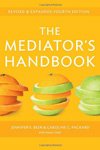 Verdict: Not for Me, Maybe for You
Verdict: Not for Me, Maybe for You
The Mediator’s Handbook: Revised and Expanded Fourth Edition
By Jennifer E. Beer & Caroline C. Packard (British Columbia, Canada: New Society Publishers, 2012). 194 pgs. $18.47. Order, www.amazon.com.
Reviewed by Kristin A. Degeneffe
Mediation is a valuable topic for attorneys looking to add to their repertoire of problem-solving tools. The Mediator’s Handbook: Revised and Expanded Fourth Edition is a guide to the formalized mediation process and focuses, as the name suggests, on the mediator. It does not, however, go out of its way to speak to attorneys or even the legal context. Frankly, it reads more like an undergraduate psychology text without the intriguing stories that make such volumes memorable.
The target readership is broad. Professional mediators, managers, organizers, teachers, and “anyone working with clients” are included in the enumerated audience. However, if mediation is an active component of your practice, I suspect you will find The Mediator’s Handbook too simple. The book outlines the mediation process with generality and follows with a laundry list of mini scenarios and prescriptions for the mediator’s behavior. That said, it is concisely written and well organized, and thus, can be skimmed. To the extent that you find the basics onerous, the book easily permits moving to sections of interest.
Certain of the Handbook’s helpful observations deserve mention. It counsels mediators to consider confidentiality concerns including warnings against making phone recordings (audio or visual) of the mediation. Given the pervasiveness of smart phones, these considerations are essential. Along the same lines, forming consensus about the privacy of the mediator’s and parties’ notes is necessary, particularly against the backdrop of litigation. Whether notes are kept or destroyed, these confidentiality decisions should occur before the beginning of the mediation.
The suggestions for choosing the language of proposed agreements should generate hesitation among attorneys. The Handbook focuses on producing the substance of agreements and, for better or worse, many legal contexts require equal attention to form. The ability to explain the meaning and purpose of legal language in agreements is a discussion this author would appreciate seeing in future editions of the Handbook.
Mediation seems to be an area in which much of the learning is done “the hard way” through practice, attention, and persistence. The Handbook preps the mind for this work but it is not enough for mediators addressing legal disputes. Attorneys mediating in a particular practice area would do well to find a topical treatise in addition to, or in lieu of, The Mediator’s Handbook.
Kristin Degeneffe, U.W. 2011, practices employment and administrative law at Aplin & Ringsmuth, Deerfield.
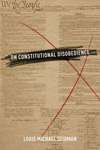 Verdict: It’s a Keeper
Verdict: It’s a Keeper
On Constitutional Disobedience
By Louis Michael Seidman (New York, NY: Oxford Univ. Press, 2012). 176 pgs. $21.95. Order, www.oup.com.
Reviewed by Nilesh Patel
This is one thought-provoking book. It is short but proved to not be a quick read. That is appropriate for the subject, because the author suggests a radical shift in our understanding of the U.S. Constitution. Forget looking for the founders’ intent or treating the Constitution as a living, adaptable document. Seidman, a professor at Georgetown Law School, argues we should simply disobey the Constitution when it conflicts with something we want to do or with our innate sense of fairness or justice.
The proposal is clearly jarring. The United States operates under the rule of law, and our legal system respects the four corners of a contract. How then can we take seriously a suggestion to ignore the very foundation of that system? How can we take seriously an approach that appears results oriented rather than beginning with an appreciation of our legal obligations?
Seidman discusses theoretical and practical reasons why we should not be obligated to follow the Constitution. He suggests that American history is filled with examples of situations in which a branch of government ignored the document or perhaps read it incorrectly. Seidman then argues that rather than relying on a flawed, politically motivated, and even undemocratic Constitution to arbitrate our differences, we should look to the document as an expression of our national values and aspirations.
This book is not the place to look for answers on how to manage such a shift in perspective. There is not enough space nor is it the book’s purpose. Rather, Seidman asks a basic, underlying question: why should we care at all what the Constitution says? Even if the argument is unconvincing, the discussion is very engaging and will deepen a reader’s perspective on the place and significance of the U.S. Constitution.
Nilesh P. Patel, U.W. 2002, operates Mahadev Law Group, Madison.
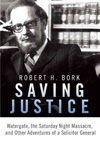 Verdict: It’s a Keeper
Verdict: It’s a Keeper
Saving Justice: Watergate, the Saturday Night Massacre, and Other Adventures of a Solicitor General
By Robert H. Bork (New York, NY: Encounter Books, 2013). 136 pgs. $23.99.
Reviewed by Matthew M. Fernholz
For most Americans under age 60, memories of the late Robert Bork (assuming there are any memories at all) are limited to his failed nomination to the U.S. Supreme Court in 1987 and his subsequent career as a social commentator. But before Sen. Ted Kennedy gave his notorious “Robert Bork’s America” speech, Bork was primarily known for his role in the so-called Saturday Night Massacre, an event that hastened the demise of Richard Nixon’s presidency. Published posthumously, Saving Justice provides a valuable counter-history to much of what has been written about the firing of Watergate special prosecutor Archibald Cox in October 1973.
In May 1973, U.S. Attorney General Elliot Richardson appointed Cox to independently investigate and prosecute the break-in at the Watergate Hotel. When Cox learned that the White House had a taping system, he issued a subpoena for the tapes. Nixon, concerned about weakening the presidency if he turned over parts of the tapes related to national security and other non-Watergate matters, initially offered to provide authenticated versions of the requested tapes. Cox refused, so the White House responded with what it thought was a reasonable compromise: Sen. John Stennis (D-Miss.), respected on both sides of the aisle, would review the tapes and sift the Watergate-related dialogue from extraneous materials. Nixon told Richardson to make clear to Cox that this was the final offer. Left unspoken was what would happen if Cox refused the compromise. Cox held a press conference to announce he was refusing the Stennis option. Then came the massacre.
Nixon pressured Richardson to fire Cox. Richardson met with his deputy, William Ruckelshaus, and Solicitor General Bork, the number-three official in the Justice Department. Richardson and Ruckelshaus, both of whom promised the Senate in their confirmation hearings that they would not fire the Watergate special prosecutor absent “extraordinary improprieties,” said they would resign rather than terminate Cox. Richardson asked Bork if he would be willing to do it: “The gun is in your hand – pull the trigger!”
Bork, skeptical of the concept of a special prosecutor because of the lack of accountability, believed the President had the legal authority to fire Cox. He thus was willing to fire Cox but said he would then resign to avoid looking like a Nixon “apparatchik.” Because the solicitor general is the last stop in the line of succession at the Justice Department, Richardson and Ruckelshaus pleaded with Bork to reconsider, fearing mass resignations and the appointment of a political sycophant as acting attorney general if Bork left along with them. Persuaded that firing Cox was the only way to preserve working order in the DOJ, Bork reluctantly agreed to stay, later saying, “I knew I could not resign, but still wished circumstances had allowed me to make the Massacre a murder-suicide.”
Although Bork did the deed, he took no pride in his new position as acting attorney general, refusing Nixon’s offer to be appointed as the permanent attorney general and also foreswearing the office and car service reserved for the position, saying, “I don’t enjoy playing queen for a day.”
Watergate was not the only challenge to confront Bork as solicitor general. The book also discusses Justice William Douglas’s injunction against the bombing campaign in Cambodia, Nixon’s offer to Bork to become his primary defense attorney, and the brief Bork wrote during the prosecution of Vice President Spiro Agnew for bribery. It is doubtful any U.S. solicitor general has faced the complexity and gravity of challenges that Bork was presented with in just his first few months on the job. This book brings into sharp focus the tumultuous year of 1973 and is a worthy capstone to a remarkable career in the law.
Matthew M. Fernholz, Marquette 2010, is a law clerk to Wisconsin Supreme Court Justice Michael J. Gableman. He previously clerked for Judge Paul F. Reilly, Wisconsin Court of Appeals.
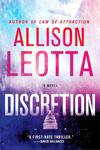 Verdict: Not for Me, Maybe for You
Verdict: Not for Me, Maybe for You
Discretion
By Allison Leotta (Simon & Schuster, 2012). 336 pgs. $20. Order, books.simonandschuster.com.
Reviewed by Kara M. Burgos
Discretion would have been an admirable first attempt at legal-suspense writing; unfortunately, it was not Allison Leotta’s first legal-suspense novel. Although the story is interesting, it is predictable, in that the plot has been played out multiple times on screen and in other novels. There are a few twists to keep the reader engaged but overall, there is nothing new or “thrilling” about the story. Most unfortunate is the lack of character development. There are three main characters and a list of supporting ones but the author gives only surface explorations of their traits and personalities. It was a lackluster read, despite the rave reviews from several of my favorite authors on the book’s cover.
Discretion takes place over only a few days, so the action is fast paced, but it skips rather quickly over some events and lingers unnecessarily over other less important details. The setting is Washington, D.C., amid high-powered politicians, lawyers, and their clients, legal and otherwise. The book is named for an escort agency that specializes in being discreet, to protect both its clients and its “girls.” The discretion begins to give way when one of the escorts is found murdered outside the Capitol. The book follows the homicide investigation.
The author introduces us to the head prosecutor; his assistant, who is also his lover; the lead detective; and the local FBI liaison. Minor players include the lead suspects. The story flits about from a homicide investigation to courtroom tactics to the escort business. In between, the reader is entangled in a love story fraught with commitment issues, exploration of the cycle of domestic violence and assault, and the inner workings of life as an escort. While all interesting, these discussions are too brief to make much of an impact and serve just as filler for the supposed “thriller” for which the book was touted.
If the reader is familiar with the main character, Anna, from the author’s first novel, he or she may enjoy discovering more about her, but I was left wanting more from this book. It was not billed as part of a series, but allusion to other events and times left the reader with questions that likely would have to be answered by going to Leotta’s first novel. I was not impressed enough to go backwards. Overall, it worked for a quick no-nonsense read, but I would not count on it to keep you awake at night and make you want to get back to your book.
Kara M. Burgos, Marquette 1995 cum laude, is a shareholder with Moen Sheehan Meyer Ltd., La Crosse. She also is a circuit court commissioner and serves on the Office of Lawyer Regulation’s District 5 Committee.
